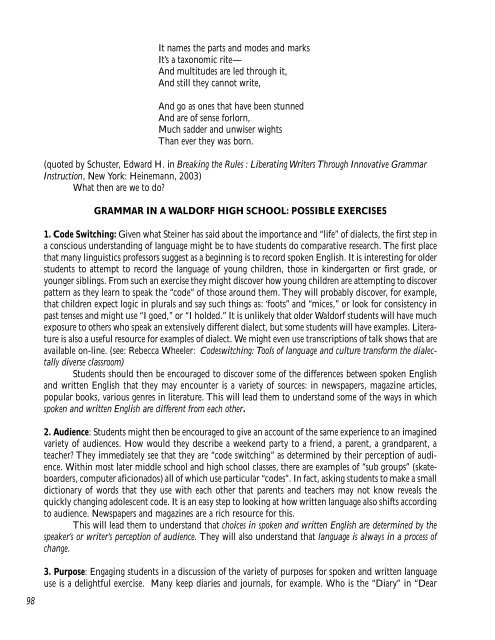Colloquium on English - Research Institute for Waldorf Education
Colloquium on English - Research Institute for Waldorf Education
Colloquium on English - Research Institute for Waldorf Education
Create successful ePaper yourself
Turn your PDF publications into a flip-book with our unique Google optimized e-Paper software.
98<br />
It names the parts and modes and marks<br />
It’s a tax<strong>on</strong>omic rite—<br />
And multitudes are led through it,<br />
And still they cannot write,<br />
And go as <strong>on</strong>es that have been stunned<br />
And are of sense <strong>for</strong>lorn,<br />
Much sadder and unwiser wights<br />
Than ever they was born.<br />
(quoted by Schuster, Edward H. in Breaking the Rules : Liberating Writers Through Innovative Grammar<br />
Instructi<strong>on</strong>, New York: Heinemann, 2003)<br />
What then are we to do?<br />
GRAMMAR IN A WALDORF HIGH SCHOOL: POSSIBLE EXERCISES<br />
1. Code Switching: Given what Steiner has said about the importance and “life” of dialects, the first step in<br />
a c<strong>on</strong>scious understanding of language might be to have students do comparative research. The first place<br />
that many linguistics professors suggest as a beginning is to record spoken <strong>English</strong>. It is interesting <strong>for</strong> older<br />
students to attempt to record the language of young children, those in kindergarten or first grade, or<br />
younger siblings. From such an exercise they might discover how young children are attempting to discover<br />
pattern as they learn to speak the “code” of those around them. They will probably discover, <strong>for</strong> example,<br />
that children expect logic in plurals and say such things as: ‘foots” and “mices,” or look <strong>for</strong> c<strong>on</strong>sistency in<br />
past tenses and might use “I goed,” or “I holded.” It is unlikely that older <strong>Waldorf</strong> students will have much<br />
exposure to others who speak an extensively different dialect, but some students will have examples. Literature<br />
is also a useful resource <strong>for</strong> examples of dialect. We might even use transcripti<strong>on</strong>s of talk shows that are<br />
available <strong>on</strong>-line. (see: Rebecca Wheeler: Codeswitching: Tools of language and culture trans<strong>for</strong>m the dialectally<br />
diverse classroom)<br />
Students should then be encouraged to discover some of the differences between spoken <strong>English</strong><br />
and written <strong>English</strong> that they may encounter is a variety of sources: in newspapers, magazine articles,<br />
popular books, various genres in literature. This will lead them to understand some of the ways in which<br />
spoken and written <strong>English</strong> are different from each other.<br />
2. Audience: Students might then be encouraged to give an account of the same experience to an imagined<br />
variety of audiences. How would they describe a weekend party to a friend, a parent, a grandparent, a<br />
teacher? They immediately see that they are “code switching” as determined by their percepti<strong>on</strong> of audience.<br />
Within most later middle school and high school classes, there are examples of “sub groups” (skateboarders,<br />
computer afici<strong>on</strong>ados) all of which use particular “codes”. In fact, asking students to make a small<br />
dicti<strong>on</strong>ary of words that they use with each other that parents and teachers may not know reveals the<br />
quickly changing adolescent code. It is an easy step to looking at how written language also shifts according<br />
to audience. Newspapers and magazines are a rich resource <strong>for</strong> this.<br />
This will lead them to understand that choices in spoken and written <strong>English</strong> are determined by the<br />
speaker’s or writer’s percepti<strong>on</strong> of audience. They will also understand that language is always in a process of<br />
change.<br />
3. Purpose: Engaging students in a discussi<strong>on</strong> of the variety of purposes <strong>for</strong> spoken and written language<br />
use is a delightful exercise. Many keep diaries and journals, <strong>for</strong> example. Who is the “Diary” in “Dear

















